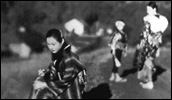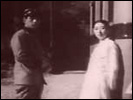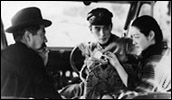Mr. Thank You
- Year
- 1936
- Original title
- Arigatou-san
- Japanese title
- 有りがとうさん
- Director
- Cast
- Running time
- 78 minutes
- Published
- 15 April 2004



by Jasper Sharp
The canons of film history are a genuinely curious thing. Ever wondered who decides which films or directors are hailed as all-time greats and which get relegated to the darkest corners of obscurity? And how do these "best of" lists of "must see" films become so concretised over the years that you can guarantee with an almost 100% certainty that Citizen Kane will come up tops again, or that the tacitly accepted genius of directors such as Stanley Kubrick or Alfred Hitchcock will go unchallenged year after year? And why is it that, amongst the endless lists of American and European names, so few non-Westerners ever get mentioned, and when they do it is always inevitably the same ones that get checklisted again and again - for example, India's Satyajit Ray or Japan's Akira Kurosawa?
Looking through these top 10 lists, such as the epic survey published in Sight and Sound in 2002, you come away with the impression that most of the critics polled for their opinions thought they were answering an exam question, such is the unity of their responses. Even if we agree that Ozu is the greatest Japanese film director of all time, and that as such his name should be included in a top 10 of The World's Best Films if only just as a token representative of the Far East, then did those who singled out Tokyo Story as their choice above the likes of I Was Born But…, Early Summer, or Floating Weeds do so honestly because it was their favourite Ozu film, or did they do so because it was the one that the other voters were most likely to have seen?
I don't want to take away credit from these directors, because they all have made wonderful films, but it is a terrible tragedy if they have been elevated to such a status (as Donald Richie points out, to that of "brand names") that their work is seen as the only unique and exceptional films made in their respective countries during their respective periods. More than anything, it gives a particularly skewed vision of the cinematic history of the country in question, especially given the sheer size of some national industries at the time. To take Japan as an example, yes, it's true - Ozu, Kurosawa and Mizoguchi all pioneered their own styles throughout the course of their careers. But there were plenty of other directors doing their own thing at the same time as well.
Take the case of Hiroshi Shimizu, whose 100th anniversary last year was considerably overshadowed by that of his younger contemporary at Shochiku, Yasujiro Ozu. Despite receiving some degree of praise and attention in books by Donald Richie and Noel Burch, Shimizu still remains virtually unknown in the West and, even more curiously, rather neglected in his native country as well.
Fortunately, even though none of his films are currently available on DVD anywhere, a retrospective of ten of his works at the 2003 Tokyo Filmex (including a stunning live orchestra-accompanied screening of his silent classic Japanese Girls at the Harbour) looks set to put him on the lips of modern audiences at long last. During the festival, in a virtually unprecedented occurrence, Shimizu's The Ornamental Hairpin (Kanzashi, 1941), an adaptation of a short story by Masuji Ibuse, rocked the vote against all manner of modern competition (including the Korean cult sci-fi fave Save The Green Planet) to walk away with the audience prize - more than 60 years after it was made.
With a career stretching over thirty years and 160 films (a recent Japanese publication on the director lists 163, whilst the Japanese Movie Database lists 166) most of which are no longer in existence, Shimizu was much respected by his peers at Shochiku during the twenties and thirties, lauded for his modernist dramas, and later for his naturalistic and highly popular portrayals of children in films such as Children in the Wind (Kaze no Naka no Kodomo, 1937) and Introspection Tower (Mikaeri no To, 1941).
Though his work is not as easily reducible in terms of style as Ozu's immaculate home dramas, Mizoguchi's female-dominated exoticism, or Kurosawa's dramatically potent epics, looking across the full range of Shimizu's output reveals a number of recurrent motifs that combine to paint a particularly vivid portrait of the vast social, political, and economic upheavals that Japan was undergoing at the time.
For the large part eschewing studio shooting and period historical settings, from the mid-30s onwards Shimizu increasingly took his stories out on the road to focus on the interactions between travellers, tourists, itinerant entertainers, migrant workers, and other marginals thrown together by circumstance. One of his most powerful films, Children of the Beehive (Hachi no Su no Kodomo, 1948), focused on a group of war orphans roaming around the ravaged countryside and scavenging for food and odd jobs, led by a returning soldier with no home to go to. A particularly affecting scene in this film is shot outside a bomb-shattered temple on the still visibly flattened rubble of the city of Hiroshima.
All of these qualities are perhaps most fully manifested in one of his most entertaining films, Mr. Thank You, based on a short story by Nobel prize-winning novelist Yasunari Kawabata (whose own more concrete link with the world of cinema came with his contribution to the avant-garde A Page of Madness in 1926). The travelling inn was one of Shimizu's favoured locales in which to assemble his motley crew of characters, but in this film, which might possibly bear the distinction of being the first ever Japanese road movie, the setting is a bus that runs between Izu and Tokyo.
The film takes its name from the bus' driver, a young man who has earned his title through his consummate politeness in thanking everyone he passes along the road for letting him overtake. A familiar face on his route, delivering messages between villages, buying a record for a girl in a smaller town further along the road, and with a friendly smile and a greeting for everyone he meets, he is as much a part of the local scenery as the mountains and trees through which the bus wends its way.
Though this anonymous driver remains the focal point around which the films' minor dramas take place, he is never the active dramatic agent. With no real plot as such, the narrative consists of a series of vignettes based around the interactions between the bus' passengers. With none of them ever revealing their names to one another, all of them begin and remain virtual strangers, their numbers dwindling or expanding as more are either picked up or dropped off along the route.
The main drive of the story is a mother, who, forced by poverty, is escorting her 17-year-old daughter to Tokyo to sell her into prostitution. Eyes permanently cast downwards, the girl is sad and tearful, not to mention more than a little embarrassed about the openness with which her mother informs their fellow riders about the purpose of their mission. "Tell them I'm visiting relatives", she insists.
Other passengers include an uppity and impatient older man with an elaborate and obviously fake-looking handlebar moustache and a sassy young woman in moga ("modern girl") clothing who swigs from a bottle of whiskey and teases cigarettes from the driver. This woman is clearly a prostitute herself, and an augury of what the younger girl is to become should she complete the journey to Tokyo. Whilst the pompous man in the suit tries to cajole the pretty maiden into sitting next to him, she doles out the sisterly advice, "The city is full of badgers and sly foxes", and warns her that few people ever make the return journey home.
The trip is kept consistently enlivened by the interplay between these main characters. But as the bus rides through this epic mountainous rural landscape, we are harshly reminded that along with the rickshaws and herds of cattle which are soon left behind, a large proportion of the drifting, migratory people walking along the roadside do so through economic necessity. A group of Korean immigrant labourers appear at one juncture and later, as the bus nears Tokyo, the driver reminds us of the tragedy of the young girls forced to walk miles to neighbouring towns to work in the mills and factories in increasing numbers to fuel the country's rapid industrialisation.
Stylistically the film is fascinating. Shot on location, the action passes by almost completely in real-time, virtually all of it taking place within the cosy, isolated bubble of the bus interior, save for one sequence where the voyagers stop for a rest. As they pass the periphery characters on the roadside with a cheery wave and a thank you, the image dissolves from the forward-moving images shot from a camera mounted on the front of the bus to a reverse shot of the bus drawing away, giving the illusion of the bus passing over these fellow road-users. This continuous perpendicular flow of movement into the screen is a consistent visual trope in Shimizu's work, and along with the elliptical plot structure foreshadows recent work by the directors Abbas Kiarostami (A Taste of Cherry, 1997; Ten, 2002) and Shinji Aoyama (Eureka, also largely set aboard a bus, and To The Alley, both 2000) which it precedes by over half a century.
A throwback to the days when the words "arigato" (thank you) meant something more sincere than a mere reflex action, Mr. Thank You's appeal to our more nostalgic side is undeniable. The characters are interesting, the dramatic approach compelling, and the style still seems innovative.
But there's a serious undercurrent beneath the almost whimsical approach to the drama, a tangible sense of sadness and regret at the direction Japan was heading. It is perhaps no surprise that during the war Shimizu's works fell out of favour with the establishment. After the production of Sayon's Bell (Sayon no Kane, 1943), shot and set in Japanese-occupied Taiwan, he was ousted from Shochiku studios and for the next two decades either produced his work through smaller companies, such as his own Hachinosu Eiga (Beehive Films) or the newly founded Shintoho studios.
However, as the audience reception at Filmex shows, for all the years that have elapsed since his heyday, with his mixture of pathos, humour, context, and critique, Shimizu remains an essential part of Japanese film history, his work remaining as fresh and accessible as it ever was.